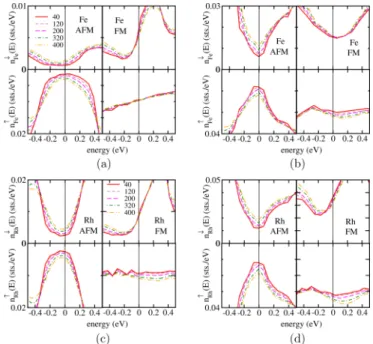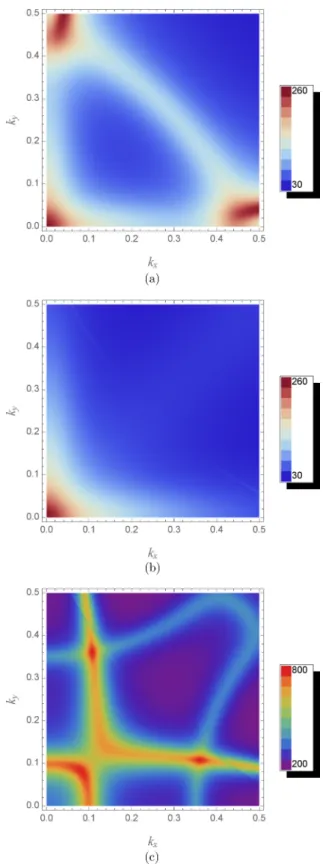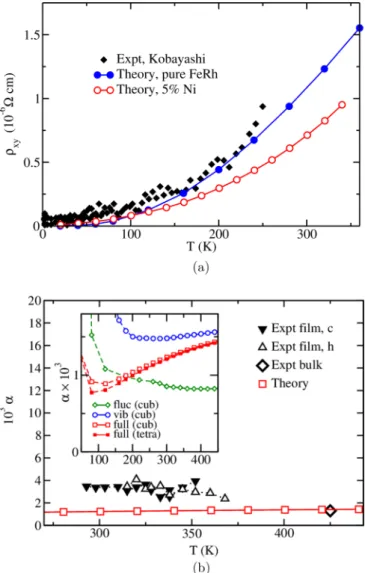Temperature-dependent transport properties of FeRh
S. Mankovsky, S. Polesya, K. Chadova, and H. Ebert
Department Chemie, Ludwig-Maximilians-Universität München, 81377 München, Germany J. B. Staunton
Department of Physics, University of Warwick, Coventry, United Kingdom T. Gruenbaum, M. A. W. Schoen, and C. H. Back
Department of Physics, Regensburg University, Regensburg, Germany X. Z. Chen and C. Song
Key Laboratory of Advanced Materials (MOE), School of Materials Science and Engineering, Tsinghua University, Beijing 100084, China
(Received 9 June 2016; revised manuscript received 16 March 2017; published 25 April 2017) The finite-temperature transport properties of FeRh compounds are investigated by first-principles density- functional-theory-based calculations. The focus is on the behavior of the longitudinal resistivity with rising temperature, which exhibits an abrupt decrease at the metamagnetic transition point, T = T
m, between ferro- and antiferromagnetic phases. A detailed electronic structure investigation for T 0 K explains this feature and demonstrates the important role of (i) the difference of the electronic structure at the Fermi level between the two magnetically ordered states and (ii) the different degree of thermally induced magnetic disorder in the vicinity of T
m, giving different contributions to the resistivity. To support these conclusions, we also describe the temperature dependence of the spin-orbit-induced anomalous Hall resistivity and Gilbert damping parameter.
For the various response quantities considered, the impact of thermal lattice vibrations and spin fluctuations on their temperature dependence is investigated in detail. Comparison with corresponding experimental data shows, in general, very good agreement.
DOI: 10.1103/PhysRevB.95.155139
I. INTRODUCTION
For a long time the ordered equiatomic FeRh alloy has attracted much attention owing to its intriguing temperature- dependent magnetic and magnetotransport properties. The crux of these features of this CsCl-structured material is the first-order transition from an antiferromagnetic (AFM) to ferromagnetic (FM) state when the temperature is increased above T m = 320 K [1,2]. In this context the drop in the electrical resistivity that is observed across the metamagnetic transition is of central interest. Furthermore, if the AFM to FM transition is induced by an applied magnetic field, a pronounced magnetoresistance (MR) effect is found ex- perimentally with a measured MR ratio of ∼50% at room temperature [2–4]. The temperature of the metamagnetic transition as well as the MR ratio can be tuned by the addition of small amounts of impurities [2,5–8]. These properties make FeRh-based materials very attractive for future applications in data storage devices. The origin of the large MR effect in FeRh, however, is still under debate. Suzuki et al. [9]
suggest that, for deposited thin FeRh films, the main mech- anism stems from the spin-dependent scattering of conducting electrons on localized magnetic moments associated with partially occupied electronic d states [10] at grain boundaries.
Kobayashi et al. [11] have also discussed the MR effect in the bulk ordered FeRh system, attributing its origin to the modification of the Fermi surface across the metamagnetic transition. So far only one theoretical investigation of the MR effect in FeRh has been carried out on an ab initio level [12].
II. COMPUTATIONAL DETAILS
The present study is based on spin-polarized electronic structure calculations using the fully relativistic multiple scattering Korringa-Kohn-Rostoker (KKR) Green’s function method [13,14] with the framework of spin density functional theory. For the self-consistent calculations a parametrization for the exchange and correlation potential based on the general gradient approximation (GGA) [15] has been used.
For the charge and potential representation the atomic sphere approximation (ASA) has been applied. For the wave functions and corresponding matrices of the KKR formalism the cutoff value l max = 3 has been used for the angular momentum expansion.
The central advantage of the KKR formalism is that it gives direct access to the retarded single-particle Green’s function G + ( r, r ,E), which is given by [16–18]
G + ( r, r ,E) =
Z m ( r,E)τ mn (E)Z n × ( r ,E)
− δ mn
Z n ( r,E)J n × ( r ,E)(r n − r n )
+ J n ( r,E)Z n × ( r ,E)(r n − r n ), (1)
where the spatial vectors r and r are assumed to be within the
atomic cell centered at sites R m , R n , respectively. Within the
fully relativistic formulation used here the combined quantum
number = (κ,μ) stands for the relativistic spin-orbit and
magnetic quantum numbers κ and μ, respectively [19].
Accordingly, Z n and J n are four-component wave functions obtained as regular and irregular solutions to the single-site Dirac equation for the isolated potential well V n centered at site n, respectively. The symbol “×” as a superscript of Z n and J n indicates the left-hand-side solution to the Dirac equation. Dealing with a magnetically ordered system within the framework of spin density functional theory, the potential V n is spin dependent. As a consequence Z n =
Z n (and also J n ) stands for a superposition of various partial waves with spin-angular character [20,21]. Finally, the quantity τ nn
is the so-called scattering path operator that represents the transfer of a wave coming in at site n with character to a wave outgoing from site n with character and all possible scattering events taking place in between [17].
The scheme sketched above to calculate the retarded Green’s function gives direct access to the density of states (DOS) n(E) via the expression
n(E) = − Im π
G + ( r, r,E) c d 3 r. (2) Information on the electronic structure more detailed than that given by the DOS is given by the Bloch spectral function (BSF) A B ( k,E). In terms of the retarded Green’s function, this quantity is defined via
A B ( k,E) = − Im π
n,m
exp[ı k · ( R n − R m )]
×
G + ( r + R n , r + R m ,E) c d 3 r, (3) where again the angular brackets specify an appropriate configurational average. For a perfectly ordered system the BSF would be a set of Dirac delta functions, A B ( k,E) =
γ δ(E − E k
γ


